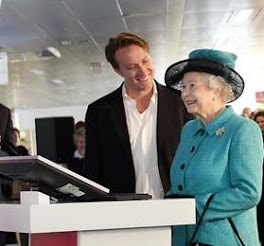I was toying with the idea of posting on the subject of brambles - do they have some kind of toxin that delays wound-healing? Or there again, is it simply a case of advancing age - a slowing down of repair mechanisms?
So I did some reading on age v wound repair. Sure enough, those defensive mechanisms become less efficient as one gets older. But there were reminders about nutritional status that are relevant to younger folk too, notably the need for plenty of zinc and Vitamin C (ascorbic acid) in one's diet.
I mulled that over for a week or two, and then remembered something. I'd bought some mega-dose tablets of Vitamin C from a French pharmacist last summer for my experiments with modelling the Turin Shroud (linen becomes easier to scorch if impregnated with lemon juice ).
Each had a whopping amount of Vitamin C (1000mg which is over 12 times the RDA of Vitamin C in the UK - 80 mg/day). So why not play safe, and take just one or two of those unused Vitamin C tablets, well spaced?
So I took one of them, and a second a few days later. Result - bramble scratches still highly visible, day after day, no instant curative action of Vitamin C. So I put Vitamin C right out of my mind - for a while.
Two weeks ago or so, maybe the same time interval approximately after taking the Vit C pills, I felt and heard a joint crack in my finger, and thought "Hmmm, that's unusual.".
Then it happened again, and again, and it's been happening on and off for the last few days. That was worrying (my grandmother had crippling arthritis and joint enlargement well before my present age). For days I racked my brain, trying to think what had changed as regards diet or lifestyle that might explain those clicking joints (one just an hour or so before posting this). Was it the re-decorating of rooms over Christmas, with much use of scrapers and paintbrushes?
So one went googling, and the initial results were not promising. Clicking joints can be an early sign of arthritis (rheumatoid? osteo-? sorry can't recall). Go and see your doctor it said if you have clicking joints.
Then, early this morning, a thought dawned. Might it be something to do with those two tablets of Vitamin C, despite having had them at least a couple of weeks ago.
So I went back to Google, and cut to the chase. Were there any reports of mega doses of Vitamin C causing joints to click. I immediately found a report that corroborated my first fears.
Now I know that internet searches can all too often lead to one confirming any old hunch, given the abilility of Google etc to filter out all but the thing one is specifically looking for, instantly finding needles in haystacks. But in this instance the corroboration looked too good, too specific to be an accident. Vitamin C supplements do indeed affect one's finger joints (at least) causing them to 'click or 'crack''.
Incidentally, the advice on the above site from the resident health expert, along the lines that Vitamin C is good for one in several different ways, so don't worry, strikes me as as somewhat short-sighted,given there's no consideration of dose, but never mind, let's try and stay constructive.
The question now is this: are clicking joints a sign of joint injury? Might continued consumption of those pills lead to progressive damage - acute arthritis in fact?
The answer right now is that I don't know. But I shall be researching the topic some more, collecting information on the precise role of Vitamin C and joints (it's thought to be due to synthesis of collagen, a component of the cartilage that allows the end of one joint to slide smoothly on another). I may also decide in the interests of science and medicine to take some more of those Vit C pills to see if the symptoms return, but first I must wait until the present clicking stops (assuming hopefully it does).
Does anyone reading this have had symptoms similar to those of mine and the commenter above as a result of taking large supplements of Vitamin C? There might have been experience of that pre-dating the internet, given that Linus Pauling, Nobel Prize Winner in Chemistry, used to advocate back in the 70s and 80s mega-doses of Vit C as the cure-all for pretty well everything (I kid thee not). Was there an epidemic of clicking joints - or knock-on effects like arthritis?
Update 23 Jan
Later, I'll add a small section on possible mechanisms for the clicking joints, assuming there to be a cause-and-effect relationship with ascorbic acid. There are two main ones that spring to mind. The first, more obvious, is excessive synthesis of cartilage collagen, or maybe excess formation and accumulation of collagen degradation products later. But let's not forget another well-known risk of excessive Vitamin C, one that gets a mention on the packaging of my French pills, namely metabolism to oxalic acid. The latter can produce renal stones (calcium oxalate) in the kidneys of susceptible individuals. Maybe it can precipitate out in joints too (reminiscent of uric acid crystallization in gout, where joints as well as kidneys are also a prime target).
Further update 28 Jan
On Sunday last (25 Jan) both my wife and I took a 1g ascorbic acid tablet from the same pack (above). The clicking in my finger joints, mainly right hand resumed within a day or so, with approx. 5 clicks a day, usually after a period of inactivity. Interestingly my wife too is experiencing clicks - and hers too are mainly in the fingers of the right hand. My ankle joints also seem 'clickier' too.
I shall wait till the renewed clicking subsides, which from experience with the first two tablets could take weeks rather than days, and then take another (4th tablet) to see if the cycle resumes. In the meantime, I repeat my warning: there has to be a big question mark over the safety of mega doses of Vitamin C (10 times or more greater than the recommended daily intake (80mg in the UK) given what can reasonably be described as a pharmaceutical side-effect, possibly adverse effect, that is not mentioned on the packaging and for which there seems scarcely any recognition. I shall continue to scour the internet for more reports, similar to the one with which I opened this posting.
Further reading: See wiki article on 'Vitamin C megadosage'
Why was the final enzyme on the biosynthesis pathway 'de-selected' in the evolution of primates (and guinea pigs) - see above article - while conserving the initial ones, requiring de-assembly? It can hardly be due to a need to delete all enzymes deemed less than vital. Had that been the case then the entire sequence would have been deleted. Might there have been some new environmental challenge that was exacerbated by over-production of Vitamin C (while recognizing the difficulty of finding a factor common to both primate and guinea pigs, while the omnivorous rats and mice retained their capacity to synthesise the vitamin)?
29 Jan
And we read in today's Mail that career women are paying upwards of £500 a session to have a cocktail of vitamins, minerals and even NAD+ (an intracellular redox intermediate) injected intravenously into their veins.
Talk about living dangerously? How many of these people (or the quacks who relieve them of their money) know or care about the efficacy or otherwise of the control mechanisms for each and every component in the cocktail? Homo sapiens? Homo soppy 'uns more like it.
2 Feb: It's over a week now, and finger joints are still clicking.
Have been thinking about mechanism. The obvious one is that a mega dose of ascorbic acid stimulat6es an overproduction of collagen connective tissue, including cartlaginous collages that protects the end of bones within joints. But why click if there's an excess of collagen?
Here's a daring alternative, based on the fact that collagen required more than increased hydroxylation of proline (one of the prime steps that are stimulated by ascorbic acid). It requires the proline (amino acid) as well, which we make for ourselves (proline not being an essential amino acid, i.e. required entirely from diet). Might it be that the mega dose of ascorbic acid causes generalized collagen synthesis all over the body - not just the joints - mopping up all of one's recently synthesized proline, leaving insufficient for the joints, so the clicking is due to a DEFICIT of collagen in the joints, not a surplus?
Further reading:
The mystery of Vitamin C
Wiki article (just discovered - Feb 3): Cracking or popping of joints.
There are three possible mechanisms listed:
Cut and paste: I've included the blue hyper-links.
- Cavitation within the joint—small cavities of partial vacuum form in the synovial fluid and then rapidly collapse, producing a sharp sound.
- Rapid stretching of ligaments.
- Intra-articular (within-joint) adhesions being broken
I must say that first mechanism - gas bubble cavitation - sounds highly plausible, albeit somewhat unexpected at first encounter. This section from the same wiki article makes it highly plausibe:
"Synovial fluid cavitation has some evidence to support it.[2] When a spinal manipulation is performed, the applied force separates the articular surfaces of a fully encapsulated synovial joint, which in turn creates a reduction in pressure within the joint cavity. In this low-pressure environment, some of the gases that are dissolved in the synovial fluid (which are naturally found in all bodily fluids) leave the solution, making a bubble, or cavity, which rapidly collapses upon itself, resulting in a "clicking" sound.[3] The contents of the resultant gas bubble are thought to be mainly nitrogen.[4] The effects of this process will remain for a period of time known as the "refractory period," during which the joint cannot be "re-cracked," which lasts about twenty minutes, while the gases are slowly reabsorbed back into the synovial fluid
Are there no non-invasive physical/clinical techniques that might detect the temporary formation and collapse of those gas bubbles?
It's heartening to read in the rest of the entry that there's no evidence for thinking that the predisposition of joints to crack or pop is an early warning sign of disease, arthritis included. But that does not mean that a dietary supplement - mega doses of Vitamin C - that predisposes joints to crack - if that is indeed proves to be a verifiable result - can ipso facto be assumed to be a harmless side-effect.
Update Friday 6 Feb
Still occasional crackling, but my wife thinks hers has stopped. Annoyingly I cannot test the effect of a 4th tablet until the present crackling has ceased. Meanwhile I come across items like this one, with ominous warnings that joint crackling is (or can be) an early warning sign of rheumatoid arthritis:
Update Feb 9
I guess we all get floaters in the eye from time to time. Well, 3 days ago one appeared, but it's different from the previous ones. It's a regular pentagon, made up mainly of lots of little spheres, and yes, I found one reference to a pentagon-shaped floater when I googled.
Anyway, I googled again today, and guess what? The literature on floaters talks not only about ageing (guilty as charged) but collagen too. Here's a cut-and-paste. (OK, it refers to strands of collagen, with no mention of pentagons, but I'm wondering now if the mega-dose(s) of ascorbic acid are affecting more than one aspect of collagen synthesis.
Ageing process
As you get older, your risk of developing floaters increases. They tend to occur in people over 40 years of age, and are most common in those in their 60s and 70s. However, some younger people may also develop floaters.As you get older, the vitreous humour in the middle of your eyeball can become softer, and strands of a protein called collagen may become visible within it. The collagen strands may appear to swirl as your eyes move.
Normally, light travels through the clear layer of vitreous humour to reach the retina. The light-sensitive layer of cells at the back of your eye that form the retina transmit images to your brain via the optic nerve. Any objects in the vitreous humour, such as floaters, will cast shadows onto the retina.
Posterior vitreous detachment (PVD)
Floaters can be a symptom of posterior vitreous detachment (PVD). This is a common condition that occurs in around three-quarters of people over 65 years of age. PVD can occur as a result of changes to the vitreous humour as the eye gets older.As your eye ages, the central part of the vitreous humour becomes more liquid, and the outer part, known as the cortex (which contains more collagen), starts to shrink away from the retina. Floaters develop as a result of the collagen thickening and clumping together.
As well as floaters, flashing lights can be another symptom of PVD. This can occur if the outer part of the vitreous humour pulls on the light-sensitive tissue of the retina. The pulling stimulates the retina, which causes your brain to interpret it as a light signal and create the sensation of flashing lights.
I'll keep folk posted if there are any further developments.
Update: 13th Feb
Here's an important (and for me ominous) report that I had bookmarked a while ago, and have only just read in full.
"Too much Vitamin V is bad for joints "
I'll be back tomorrow with a short summary. For the meantime, its message is disturbing, especially to someone who's noticing a steady deterioration in his finger joints these last few days. Was it precipitated by those three mega-doses of Vitamin C?
Update 14th Feb
Here's a key and, for me, fascinating section, from that 2004 report above:
Arthritis specialists have long recommended that patients consume an adequate daily amount of vitamin C because the nutrient is both a potent antioxidant and a key player in the formation of joint cartilage. But would higher doses of the vitamin make bones even stronger?
Not so, Kraus reports. "More is not better," she said. "We found that the more vitamin C given, the more osteoarthritis is apparent in the joints of these animals that are predisposed to getting osteoarthritis."
Guinea pigs fed low doses of vitamin C showed the least signs of knee arthritis, Kraus said, but since they also tended to weigh much less than the medium- or high-dose animals, reductions in weight might explain that result.
Animals fed a medium dose of vitamin C -- roughly equivalent to the recommended daily allowance in humans -- had slightly more signs of knee damage. But it was the high-dose animals that fared worse, with obvious signs of arthritis and an increase of bony outcroppings on the knee called osteophytes or bone spurs.
The exact links between excess vitamin C and osteoarthritis remains unclear. "One connection that we were able to make was that vitamin C activates a protein called TGF-beta," Kraus said. (Ed. That's Transforming Growth Factor, implicated in a wide range of pathophysiology, cancer included). "When active, this protein seems to increase bone spur or osteophyte formation." Microscopic bone spurs roughen the surface of joints, she explained, triggering the irritation and inflammation that is a hallmark of arthritis.
Dr. John H. Klippel, president of the American Arthritis Foundation, said the findings "are challenging the common wisdom that increased doses of vitamin C may be helpful or protective -- in fact, it seems to be quite the opposite." He believes more study is needed into possible links between diet and bone health, especially since the origins of osteoarthritis remain a mystery.
So, it's osteoarthritis that is in the frame, not rheumatoid arthritis, and not only do the two have entirely different aetiologies, but that of the bone variety said to be a continuing mystery! I have personal reasons for being interested in those bone spurs, having been prevented from walking for some weeks, indeed months, early in 2013, buy one such overgrowth on my heel. (Later, the other one too started to go the same way). The pain was excruciating whenever one tried to place one's full weight on the affected foot - as one does when, you know, walking like. The GP said it was gout, but an acquaintance in France put me wise to what was described as a condition brought about by over-calcification.
My next task: to find out as much as I can about this TGF-beta protein, and then get up to speed on osteoarthritis. Has there been recent progress?
Update, 27th Feb 2015 : BBC video: Is it bad to crack your knuckles?






















